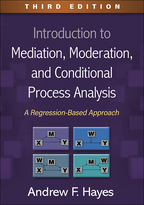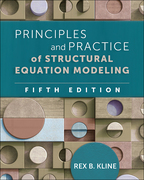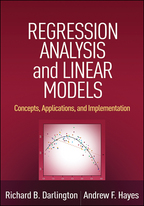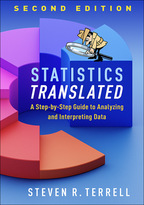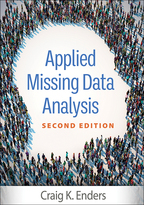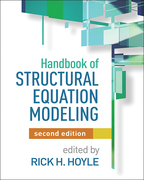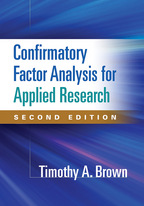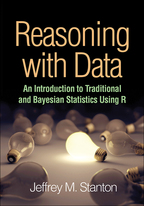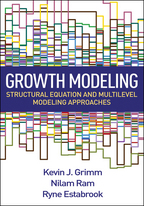Data Analysis for Experimental Design
Richard Gonzalez
1.1 Introduction
1.2 Observations and Variables
1.3 Behavioral Variables
1.4 Stimulus Variables
1.5 Individual Difference Variables
1.6 Discrete and Continuous Variables
1.7 Levels of Measurement
1.8 Summarizing Observations in Research
1.9 Questions and Problems
2. Principles of Experimental Design
2.1 The Farmer from Whidbey Island
2.2 The Experiment
2.3 The Question of Interest
2.4 Sample Space and Probability
2.5 Simulation of the Experiment
2.6 Permutations
2.7 Combinations
2.8 Probabilities of Possible Outcomes
2.9 A Sample Space for the Experiment
2.10 Testing a Null Hypothesis
2.11 Type I and Type II Errors
2.12 Experimental Controls
2.13 The Importance of Randomization
2.14 A Variation in Design
2.15 Summary
2.16 Questions and Problems
3. The Standard Normal Distribution: An Amazing Approximation
3.1 Introduction
3.2 Binomial Populations and Binomial Variables
3.3 Mean of a Population
3.4 Variance and Standard Deviation of a Population
3.5 The Average of a Sum and the Variance of a Sum
3.6 The Average and Variance of Repeated Samples
3.7 The Second Experiment with the Farmer: µT and sT
3.8 Representing Probabilities by Areas
3.9 The Standard Normal Distribution
3.10 The Second Experiment with the Farmer: A Normal Distribution Test
3.11 The First Experiment with the Farmer: A Normal Distribution Test
3.12 Examples of Binomial Models
3.13 Populations That Have Several Possible Values
3.14 The Distribution of the Sum from a Uniform Distribution
3.15 The Distribution of the Sum T from a U-Shaped Population
3.16 The Distribution of the Sum T from a Skewed Population
3.17 Summary and Sermon
3.18 Questions and Problems
4. Tests for Means from Random Samples
4.1 Transforming a Sample Mean into a Standard Normal Variable
4.2 The Variance and Standard Error of the Mean When the Population Variance s2 Is Known
4.3 The Variance and Standard Error of the Mean When Population s2 Is Unknown
4.4 The t Distribution and the One-Sample t Test
4.5 Confidence Interval for a Mean
4.6 Standard Error of the Difference between Two Means
4.7 Confidence Interval for a Difference between Two Means
4.8 Test of Significance for a Difference between Two Means: The Two-Sample t Test
4.9 Using a Computer Program
4.10 Returning to the Farmer Example in Chapter 2
4.11 Effect Size for a Difference between Two Independent Means
4.12 The Null Hypothesis and Alternatives
4.13 The Power of the t Test against a Specified Alternative
4.14 Estimating the Number of Observations Needed in Comparing Two Treatment Means
4.15 Random Assignments of Participants
4.16 Attrition in Behavioral Science Experiments
4.17 Summary
4.18 Questions and Problems
5. Homogeneity and Normality Assumptions
5.1 Introduction
5.2 Testing Two Variances: The F Distribution
5.3 An Example of Testing the Homogeneity of Two Variances
5.4 Caveats
5.5 Boxplots
5.6 A t Test for Two Independent Means When the Population Variances Are Not Equal
5.7 Nonrandom Assignment of Subjects
5.8 Treatments That Operate Differentially on Individual Difference Variables
5.9 Nonadditivity of a Treatment Effect
5.10 Transformations of Raw Data
5.11 Normality
5.12 Summary
5.13 Questions and Problems
6. The Analysis of Variance: One Between-Subjects Factor
6.1 Introduction
6.2 Notation for a One-Way Between-Subjects Design
6.3 Sums of Squares for the One-Way Between-Subjects Design
6.4 One-Way Between-Subjects Design: An Example
6.5 Test of Significance for a One-Way Between-Subjects Design
6.6 Weighted Means Analysis with Unequal n's
6.7 Summary
6.8 Questions and Problems
7. Pairwise Comparisons
7.1 Introduction
7.2 A One-Way Between-Subjects Experiment with 4 Treatments
7.3 Protection Levels and the Bonferroni Significant Difference (BSD) Test
7.4 Fisher's Significant Difference (FSD) Test
7.5 The Tukey Significant Difference (TSD) Test
7.6 Scheffé's Significant Difference (SSD) Test
7.7 The Four Methods: General Considerations
7.8 Questions and Problems
8. Orthogonal, Planned and Unplanned Comparisons
8.1 Introduction
8.2 Comparisons on Treatment Means
8.3 Standard Error of a Comparison
8.4 The t Test of Significance for a Comparison
8.5 Orthogonal Comparisons
8.6 Choosing a Set of Orthogonal Comparisons
8.7 Protection Levels with Orthogonal Comparisons
8.8 Treatments as Values of an Ordered Variable
8.9 Coefficients for Orthogonal Polynomials
8.10 Tests of Significance for Trend Comparisons
8.11 The Relation between a Set of Orthogonal Comparisons and the Treatment Sum of Squares
8.12 Tests of Significance for Planned Comparisons
8.13 Effect Size for Comparisons
8.14 The Equality of Variance Assumption
8.15 Unequal Sample Size
8.16 Unplanned Comparisons
8.17 Summary
8.18 Questions and Problems
9. The 2k Between-Subjects Factorial Experiment
9.1 Introduction
9.2 An Example of a 23 Factorial Experiment
9.3 Assumption of Homogeneity of Variance
9.4 Factorial Data as a One-Way Between-Subjects Design
9.5 Partitioning the Treatment Sum of Squares
9.6 Summary of the Analysis of Variance
9.7 Graphs That Depict the Interactions
9.8 Other 2k Factorial Experiments
9.9 Notation and Sums of Squares for a Factorial Experiment
9.10 Summary
9.11 Questions and Problems
10. Between-Subjects Factorial Experiments: Factors with More Than Two Levels
10.1 Introduction
10.2 An Example of a 4 x 3 x 2 Factorial Experiment
10.3 Partitioning the Sum of Squares into Main Effects and Interactions
10.4 Orthogonal Partitioning for Main Effects
10.5 Orthogonal Partitioning for Interactions
10.6 Effect Size for Comparisons in a Factorial Design
10.7 Performing Multiple Tests
10.8 The Structural Model and Nomenclature
10.9 Summary
10.10 Questions and Problems
11. Between-Subjects Factorial Experiments: Further Considerations
11.1 The Scheffé Test for Comparisons
11.2 Pairwise Comparisons in Factorial Designs
11.3 Unequal Sample Sizes in a Factorial Design
11.4 Individual Difference Factors
11.5 Control Variables
11.6 Random-Effect Factors
11.7 Nested Factors
11.8 Homogeneity of Variance
11.9 Summary
11.10 Questions and Problems
12. Within-Subjects Factors: One-Way and 2k Factorial Designs
12.1 Introduction
12.2 Example: One-Way ANOVA with a Within-Subjects Factor
12.3 Trend Analysis on One-Way Within-Subjects Designs
12.4 Assumptions and Effect Size Measures
12.5 2k Factorial Designs: All Within-Subjects Factors
12.6 Multiple Tests
12.7 Design Considerations with Within-Subjects Designs
12.8 Scheffé Test for Within-Subjects Factors
12.9 SPSS Syntax
12.10 Multilevel Approach to Within-Subjects Designs
12.11 Summary
12.12 Questions and Problems
13. Within-Subjects Factors: General Designs
13.1 Introduction
13.2 General Within-Subjects Factorial Design
13.3 Designs Containing Both Within-Subjects and Between-Subjects Factors
13.4 Omnibus Tests
13.5 Summary
13.6 Questions and Problems
14. Contrasts on Binomial Data: Between-Subjects Designs
14.1 Introduction
14.2 Preliminaries
14.3 Four Examples of Wald Tests
14.4 Other Statistical Tests for Comparisons on Proportions
14.5 Numerical Examples
14.6 How Do These Tests Differ and What Do They Test?
14.7 Summary
14.8 Questions and Problems
15. Debriefing
15.1 Introduction
15.2 Descriptive Statistics and Plotting Data
15.3 Presenting Your Results
15.4 Nonparametric Statistical Tests
15.5 Nonexperimental Controls
15.6 Questions and Problems
Appendix A. The Method of Least Squares
Appendix B. Statistical Tables


